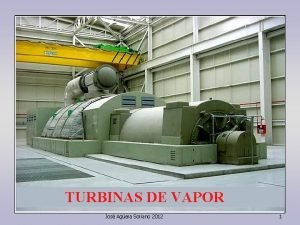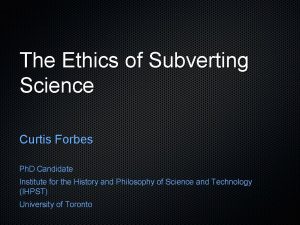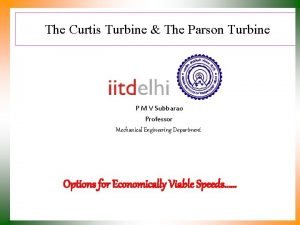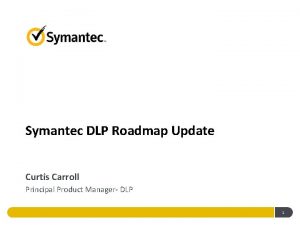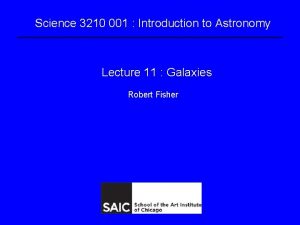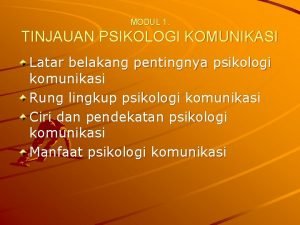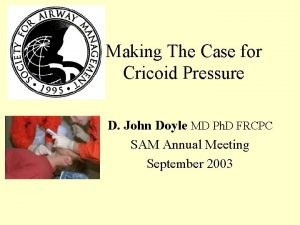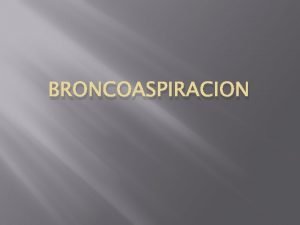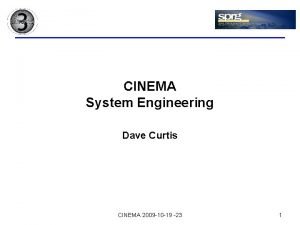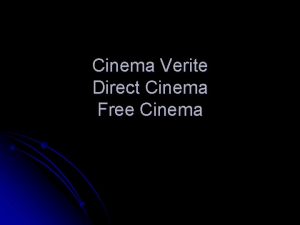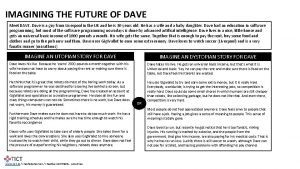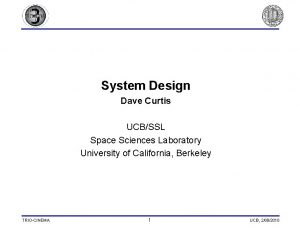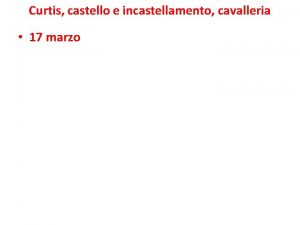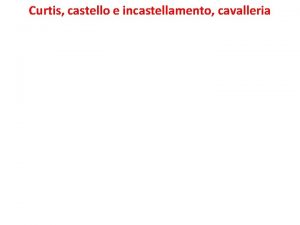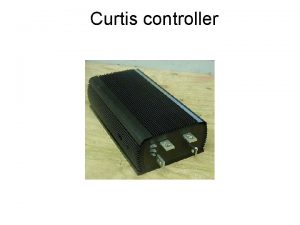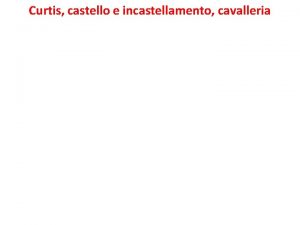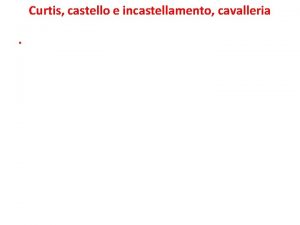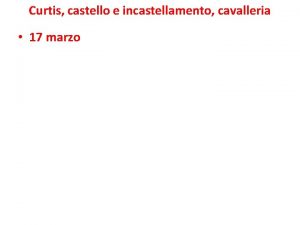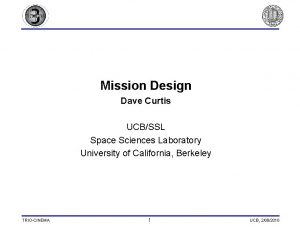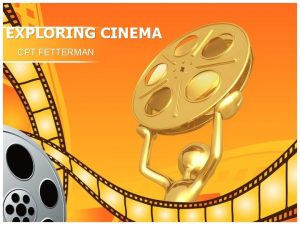CINEMA System Engineering Dave Curtis CINEMA 2009 10



















- Slides: 19

CINEMA System Engineering Dave Curtis CINEMA 2009 -10 -19 -23 1

System Engineering Tasks • Requirements Flowdown – Identify top-level science and programmatic requirements – Flow those requirements down to subsystems • Involves some system-level design – Verify by analysis and/or test that each requirement is met • Interface Control, Specifications – Document and track interfaces between subsystems • System Design – Top-level design of how the subsystems work together • Resource Allocation and Tracking – Mass, Power, Link Margin, Pointing, etc. – Money, schedule, manpower resources typically tracked by Project Manager • Technical Coordination and Evaluation – Coordinate the various technical disciplines and subsystem leads to ensure that requirements are being met – Perform technical reviews with independent reviewers to identify any issues • Reliability Engineering and Risk Management – Identify potential technical risks and failure modes and mitigate where possible • System Integration and Test Coordination – Ensure adequate testing to verify all requirements CINEMA 2009 -10 -19 -23 2

Requirements • • Top level science and programmatic requirements identified in the CINEMA NSF AO and Proposal Requirements have been extracted into a document and flowed down to the subsystem – ftp: //apollo. ssl. berkeley. edu/pub/cinema/2. %20 Systems/CINEMA_Requirements. xls – Flowdown depends on system design, which has evolved a bit since the proposal based on design trade studies – Subsystem allocations still in work • Some requirements cannot be nailed down until we have a launch selected – Orbit, Launch loads, etc. ; nominal values assumed for now • Requirements organized as follows: – Level 1 Science, Programmatic, and Mission Assurance – Level 2 Subsystems (STEIN, MAGIC, ACS, Telecom, etc) – Level 3 Components (MAGIC Boom, Torque Coils, etc) • • Documented requirements provides an agreed upon baseline for the system and subsystem engineers to design and test to, along with a rationale to remind us what we are losing if we cannot meet the requirements The System Engineer controls the requirements document. CINEMA 2009 -10 -19 -23 3

Sample Requirements CINEMA 2009 -10 -19 -23 4

Verification • Each requirement must be verified during system testing • Verify early at subsystem/component level where possible • Verify again at the full system level • Verify environmental requirements – Survive launch loads – Operate in vacuum and over temperature • Some requirement verified by analysis, but test is preferred • Ready to launch when all requirement verified – System Engineer tracks verification of requirements CINEMA 2009 -10 -19 -23 5

Interface Control Documents • An Interface Control Document (ICD) describes how one subsystem or component interacts with another or with the system as a whole – It augments the requirements document with detailed information about how the interaction between subsystems takes place such that an engineer can design his subsystem. – It includes things like mass and power, interface voltages, currents, signals, timing diagrams, pinouts, etc. • The System Engineer, together with the subsystem engineer, develops the ICD for the subsystem • MAGIC ICD first draft provided by IC. Others to follow as needed CINEMA 2009 -10 -19 -23 6

Specifications • Specifications describe the implementation of a component or subsystem – Includes details of how the item works, User information, handling details, etc. – May take the place of an ICD in some cases – Commercial equipment typically includes a specification or users manual • Specifications provide a way of documenting the design as it progresses – Important due to the transient nature of the students who are doing much of the CINEMA development – Specifications are not formally controlled documents; they are expected to evolve with the design and include by reference the schematics, listings, and other low level design information • All controlled documentation available on the CINEMA Web page – ftp: //apollo. ssl. berkeley. edu/pub/cinema • All working documentation on the CINEMA Wiki page – http: //wiki-new. ssl. berkeley. edu/index. php/Cinema – Password controlled. CINEMA 2009 -10 -19 -23 7

System Design • Current top-level design shown in following slides • Design continues to evolve • Design to meet requirements – Science, Technical, and Programmatic • Details of subsystem designs in later talks CINEMA 2009 -10 -19 -23 8

Electrical Block Diagram CINEMA 2009 -10 -19 -23 9

Mechanical Configuration CINEMA 2009 -10 -19 -23 10

Ground System CINEMA 2009 -10 -19 -23 11

Operations • Launched powered-off – • Power up into Safe mode – – • Power off ACS, Power up instruments Return to ACS Mode – • Reorient to Ecliptic Normal Spin (requires ground interaction) Science Mode – • Detumble, Spin up, Sun-normal spinning Precession Mode – • Use torque rods to determine MAG orientation ACS Acquisition Mode – • Determines major axis for stable spin Deploys magnetometer for ACS MAG Cal – • Set-up time-tagged contact windows so transceiver can be powered off between passes, freeing up power for ACS MAG Boom Deploy – – • Instrument and ACS Off Transceiver powered on, listening Contact Ground – • power-up on deployment from P-Pod Periodic drift correction Return to Safe Mode – – In the event of problems (low power, no ground contact, system reset) Power up transceiver, wait to be contacted. CINEMA 2009 -10 -19 -23 12

Resource Budgets • The following budgets are based on the proposal configuration • Design trades continue to refine the configuration CINEMA 2009 -10 -19 -23 13

Mass CINEMA 2009 -10 -19 -23 14

Power Generation CINEMA 2009 -10 -19 -23 15

Battery CINEMA 2009 -10 -19 -23 16

Power Usage Telecom Power CINEMA 2009 -10 -19 -23 17

Telecom • Assumes 1 pass/day for command / housekeeping via MHX 2400 transceiver • Remaining passes for Science recorder download with S-band transmitter CINEMA 2009 -10 -19 -23 18

Reliability • Good design practices, workmanship standards, and high quality parts are key to reliable systems – But are limited by the reality of limited cost and schedule • On such a severely cost constrained mission as CINEMA, reliability is obtained by primarily through testing – – Identifies design flaws, poor quality parts, bad workmanship Test early, test often Include margin testing (voltage, temperature, frequency, etc) Include ‘test-as-you-fly’ CINEMA 2009 -10 -19 -23 19
 Direct cinema vs cinema verite
Direct cinema vs cinema verite What is system in software engineering
What is system in software engineering Rueda curtis
Rueda curtis Ponyboy curtis personality traits
Ponyboy curtis personality traits Sodapop curtis best accomplishments
Sodapop curtis best accomplishments The outsiders character list
The outsiders character list Curtis forbes
Curtis forbes Turbine curtis
Turbine curtis Curtis carroll
Curtis carroll Heber curtis
Heber curtis Fitzu curtis syndrome
Fitzu curtis syndrome Beato curtis
Beato curtis Pentingnya komunikasi menurut susan curtis
Pentingnya komunikasi menurut susan curtis Curtis lester mendelson
Curtis lester mendelson Le curtis mappa concettuale
Le curtis mappa concettuale Heber curtis
Heber curtis Rolland curtis gardens
Rolland curtis gardens Curtis lumber hoosick falls
Curtis lumber hoosick falls Christopher paul curtis facts
Christopher paul curtis facts Curtis mendelson
Curtis mendelson


